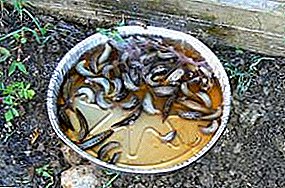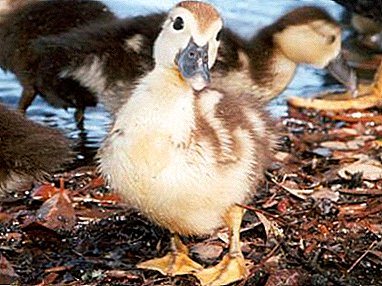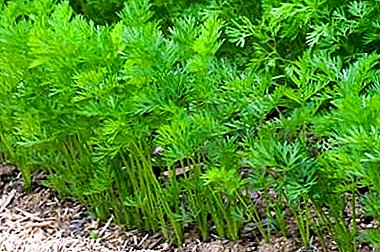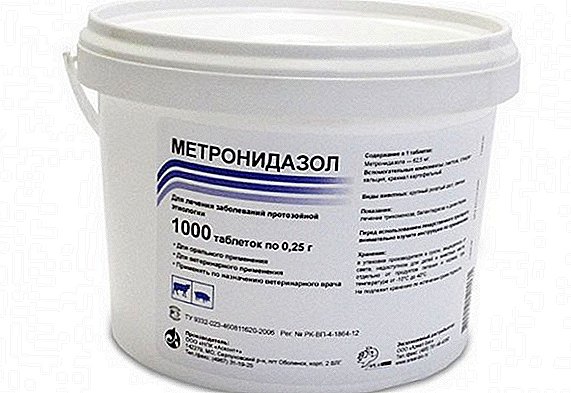
Reproduction of slugs on the site must be carefully restricted, otherwise the crops can be forgotten. Completely get rid of these nondescript clams it will not work, because they easily creep from neighboring gardens and orchards.
There are a lot of ways to combat such pests, ranging from manual collection of slugs and ending with the use of chemicals.
Fighting slugs without chemistry, this is the kind that gardeners prefer. How is going on struggle with slugs folk remedies read this material.
Folk methods

Folk remedies to combat slugs have long been tested and have high efficiency and do not harm plants and soil at all.
Many of them do not even harm the mollusks themselves, but simply scare them from planting and reliably protect plants from damage. If slugs appeared in the garden: how to fight with folk remedies?
Folk remedies for slugs, We list the best:
- wood ash;
- slaked lime;
- salt;
- soda and vinegar;
- beer;
- ammonia;
- mustard;
- needles;
- finely shelled shells or shells;
- aromatic plants.
All this must be used in conjunction with preventive measures. - timely loosening, weeding, thinning of landings, cleaning of weeds and plant residues from the site. Combating slugs in the garden with folk remedies will help to safely expel pests.
Wood ash
The fight with slugs in the country folk remedies, has its positive aspects. So, experienced gardeners use ash and for fertilizer, and to protect plants from various pests, including from gastropods. Slugs bypass the side of the place, sprinkled with ashes, because it sticks to their bodies and prevents movement.
It is necessary to carry out protective measures late at night, when mollusks crawl out of their shelters. Take a clean, dry ash and pour it along the beds, around the bushes, you can pollinate the plants themselves.
For greater efficiency slaked lime is added to the ashes or tobacco dust in a 1: 1 ratio.
About once a week ash treatment is repeated.until fresh traces of pests disappear. To protect you as efficiently as possible, you need to scatter the ashes where the main ways of slug movement are.
These paths can be identified by shiny strips of dried mucus, that leave shellfish while moving.
Salt

Common table salt against many types of slugs is a very effective weapon. In beds and flower beds, soil salinization is undesirable, but on compost heaps salt can be used safely.
Rotting plant debris attracts mucus from around the site, and, sprinkle with salt marked mucus tracks on the compost heap, you can quickly get rid of them.
This should be done after sunset and in dry weather.so that the crystals do not dissolve from moisture.
Soda
Soda against slugs, often used by gardeners, they often use non-food, and soda ash. Dry powder thickly sprinkled with clusters of slugs and individuals; under the influence of soda, bare mollusks die in minutes.
For spraying plants, the amount of soda should be reduced by half and add 20 g of soap to the solution.
Vinegar
Vinegar against slugs, very effective remedy. Slugs are dying and from vinegar. To prepare the solution will need a bucket of water and 65 ml of 9% vinegar. The solution is sprayed on the leaves of plants and watered pest accumulations.
During the processing of landings it is necessary to ensure that so that the solution does not fall under the roots. It is often impossible to spray with vinegar, as it harms the plants.
Mustard

Mustard powder for plants is harmless, but slugs die from it, therefore mustard against pests is an effective means. You can sprinkle dry soil around the bushes on the powder, or you can spray the planting solution.
It is prepared this way: in 10 liters of cool water, 150 g of mustard powder is diluted and allowed to brew for a couple of hours. Processing of plants is carried out in the evening in dry weather..
Multiple sprays at 3-4 day intervals will help to get rid of mollusks on the site for a long time.
Ammonia
Experienced gardeners use slug from slugs. An aqueous solution of ammonia is also an effective remedy against slugs. In 10 liters of water you need to dilute a liter of 25% ammonia and pour the resulting solution cracks in the groundwhere mollusks can hide.
For continuous tillage in 10 liters of water, dilute 2 liters of ammonia, and spray the beds.
Fight against slugs of ammonia, save the harvest in the country and in the garden.
Beer
Beer against slugs will help get rid of them, its smell very much attracts these voracious pests. To do this, near the plants, chosen by mollusks, dropping into the ground containers with steep walls, for example, a glass jar, a bottle with a wide neck or a plastic cup.
The edges of the containers should rise 1-2 cm above the ground. Then the container is filled with 2/3 of beer., and from above, whenever possible, establish protection against garbage and pets. On sale there are ready devices with a protective peak, very convenient for catching slugs.
You need to change the beer in the tank every 2-3 daysuntil the pests disappear from the site. Since the struggle with them in the garden is quite a difficult thing and you need to follow the instructions.
Instead of beer, milk or a mixture of water, honey and baker's yeast is suitable. For the mixture take equal amounts of honey and yeast., diluted with a small amount of water and boil for several minutes to make the mass glue-like. This mixture attracts slug smell and does not get out of the tank out.
Needles

Mulching of beds with a thick layer of needles considered one of the most effective methods against slugs. Conifer needles do not allow mollusks to move around, prick their unprotected bodies, scare away the smell itself.
In addition, rotted needles are a good fertilizer. Fir or pine branches can be laid around the plants - The result will be no less effective.
In the absence of nearby conifers for mulching beds quite tobacco and oak leaves will do, dry sawdust.
Barriers
Very often restrain the invasion of slugs barriers of coarse sand help, coffee grounds, crushed eggshell and shells, small sifting.
They are poured along the beds, around the bushes, along the perimeter of the site with low crests. You can add soot, blue vitriol, lime, from which the slugs die.
There are also ready-made barriers made of plastic, which are gutters and wide rims with curved edges. They are set around plants, and mollusks cannot overcome such an obstacle.
Pest control on cabbage
Of all the vegetables in the garden cabbage enjoys special love in slugs. Her juicy tender leaves are the best delicacy for pests, and very often they destroy the entire crop on the site.
Spraying

Experienced gardeners recommend sprinkling cabbage with hot water. This vegetable is able to withstand temperatures up to 60 degrees without consequences, while slugs die already at 40 degrees.
If pests are visible between the leaves on the heads, you need to warm the water to 40-45 degrees and thoroughly spray the plants.
Processing should not be long, so that there are no burns on the leaves. Dead mollusks after a hot shower must be selected from the sheets manually.
Well helps get rid of slugs instant coffee. In contact with caffeine, large individuals lose their activity. and orientation, and small ones die.
For spraying, it is enough to dissolve a double portion of coffee powder or granules in a glass of water, and then process the cabbage. Sensing the smell, slugs will bypass cabbage beds by, coffee does not cause any harm to plants.
Occasionally you can use a weak salt solution (100 g per bucket of water) or a liquid ammonia solution in a ratio of 1: 6.
Traps
During the day, slugs always hide from the heat in thick grass, under stones, in compost heaps. You can make traps for slugs with your own hands. For this materials needed will be needed: old boards, pieces of slate, burlap, ruberoid and other trash.
Choosing a comfortable open space, it should be thoroughly watered with water and put any material on top. Sack and rags should be additionally moistened with water.
In a day or two, slugs will gather under cover; they should be collected and taken away from the site, and shelter leave for the next batch. Look at the photo below for what a slug trap looks like.

A good trap is obtained from an ordinary plastic bottle. A bottle is crushed on the sides so that it does not roll on the ground, pour in some fruit juice, honey or beer, and laid flat between the cabbage beds.
From above you can flatten it with a flat stone or board, fixing in one position. Slugs are sure to smell and fit into the bottle., but it will be difficult for them to get out.
Bait
Another way to catch slugs is spread out on the bait site. As bait use a peel of grapefruit, orange or watermelon; for this, they are cut in half, the pulp is selected, a small hole is cut in the center of the peel.
The resulting cups in the evening set down a cut in the beds; attracted by the scent of slugs climb under the peel and stay there until morning. After this only remains check all bait and collect clams.
Preventive measures

The garden must be plowed regularly., cut grass around the perimeter, remove weeds and plant residues in time.
Thinning landings It is also a good prevention of the appearance of slugs, because they do not like open and dry places.
After harvest should thoroughly clean the soil from weedsrotting or dry foliage, under which pests can accumulate.
There are a lot of plants the smell of which deters the mollusks and keeps vegetables and berries intact:
- mint;
- garlic;
- chicory;
- lavender;
- parsley;
- mustard.
These plants can be planted not only around the perimeter of the garden, but also between beds, protecting the most vulnerable vegetables. In more detail about fight against slugs on vegetables and berry, read here. But best to deal with pests birds, hedgehogs and frogs, which attract to the site is not so difficult.
For the birds, it is enough to hang feeders in the trees and periodically pour grain into them; frogs will attract a small homemade pond with a bunch of rotted leaves on the shore.
Hedgehogs quite often wander into the garden themselves, and in order for them to settle there, you need to give them milk, cookies, something else. If there are hedgehogs or frogs in the area, No problems with slugs.
Conclusion
Control the number of slugs with the help of folk methods everyone can. The combination of preventive measures and protective plant treatments will allow in a short time to clean the area from pests and preserve the crop.
The most important thing is to do it all on time, without waiting for the slugs to multiply and completely destroy the landing.
The sooner you start to fight themthe more effective the result will be. Read also the material on how to deal with slugs in the cellar.
Useful video!












